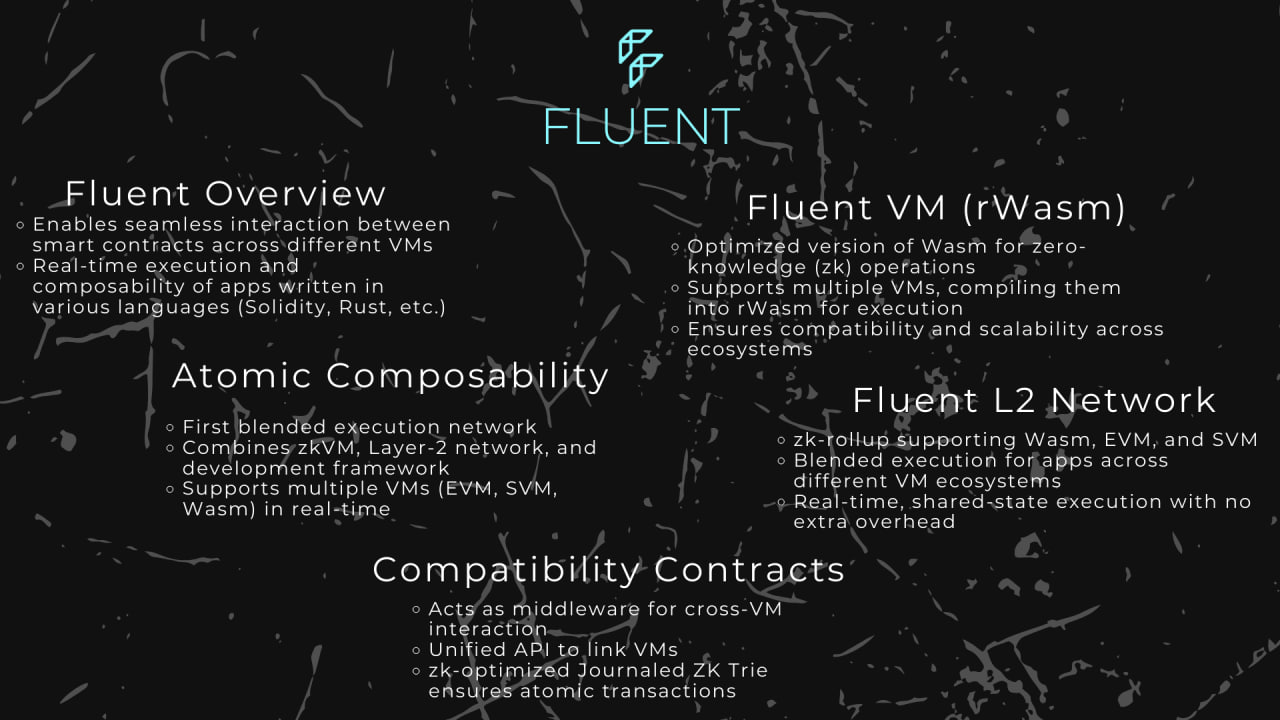Fluent is pioneering a new era of blockchain technology with the introduction of the first blended execution network. This project is set to revolutionize how decentralized applications (dApps) are built and interact, bringing real-time composability and cross-compatibility across different virtual machines (VMs) into the fold.
At its core, Fluent operates a zero-knowledge virtual machine (zkVM), a Layer-2 network, and a development framework designed to support the creation of diverse blockchain-based applications. What sets Fluent apart from other platforms is its ability to simulate the execution environments (EE) of multiple VMs simultaneously. Whether it’s the Ethereum Virtual Machine (EVM), Solana’s SVM, or WebAssembly (Wasm), Fluent brings them all together in one shared state execution environment. Developers can now build apps that combine smart contracts from different VMs written in various programming languages, such as Solidity, Rust, and more, without having to worry about interoperability issues.
Unlocking Atomic Composability Across VMs
One of Fluent’s standout features is its support for atomic composability between apps that target different VMs. Essentially, contracts built for distinct virtual machines — whether it’s an EVM smart contract in Solidity or a Wasm contract in Rust — can interact with each other seamlessly and in real-time. This means developers can create “blended” applications, where smart contracts from different ecosystems work together as if they were on the same platform. Fluent handles the interactions under the hood, ensuring that all processes are atomic and happen in sync, reducing complexity and enhancing functionality.
The Fluent VM: Streamlining Cross-VM Execution
At the heart of Fluent’s architecture is the Fluent VM, a minimally modified version of Wasm, called rWasm, optimized for zero-knowledge operations. This stripped-down version retains full compatibility with the standard Wasm instruction set but is enhanced for zk-based proofs. With rWasm, Fluent ensures that various VMs can seamlessly communicate and execute in a zk-rollup, which is crucial for secure, scalable, and efficient blockchain performance.
Fluent VM is designed to simulate and compile all supported VMs down to rWasm for execution. It achieves this through specialized system contracts that represent each VM, enabling real-time interaction and ensuring composability across different VMs. This setup not only optimizes for performance but also opens the door for future VM integrations, making Fluent a highly extensible and future-proof network.

Compatibility Contracts: Bridging the Gaps Between VMs
To facilitate smooth communication between smart contracts running on different VMs, Fluent introduces compatibility contracts. These contracts serve as a bridge, defining the execution environment (EE) standards for each VM and offering a unified API that allows contracts from different VMs to interact with each other. These compatibility contracts also incorporate zk-optimized features, ensuring that all operations remain efficient and verifiable in a zero-knowledge environment.
An important component supporting these contracts is the Journaled ZK Trie (JZKT), a reversible zk-trie structure that makes zk-proof generation across various standards more efficient. It ensures that all transactions are atomic — if any part of a transaction fails, the entire process rolls back, maintaining integrity across the network.
The Fluent L2 Network: A Hub for Real-Time Cross-VM Apps
Fluent’s Layer-2 network takes things a step further by enabling the blended execution of apps from different VM ecosystems. This zk-rollup supports both Wasm and EVM applications, making it an ideal environment for developers working across various blockchain ecosystems. Whether deploying Solidity, Vyper, or Solana Rust apps, developers can do so without additional overhead, thanks to Fluent’s compatibility with ABI encodings for all contracts.
The beauty of the Fluent L2 network lies in its real-time composability. Apps from different ecosystems can work together instantly, all within the same shared state environment. Fluent’s design is also highly modular and extensible, ensuring that as new virtual machines emerge, they can be seamlessly integrated into the network.
App Deployment: Shared vs. Dedicated Models
Fluent offers two main models for app deployment: Shared Apps and Dedicated Apps.
-
Shared Apps run on Fluent’s shared state execution environment, which allows for instant composability between apps, even across different VM targets. Developers can mix and match smart contracts from different VMs and programming languages, creating truly cross-chain applications
-
Dedicated Apps operate as independent state machines. They give developers more control, allowing for custom runtimes and modular layers like data availability (DA) and sequencing. These apps leverage Fluent for proof aggregation and zk-verification but maintain their own customizable environment
Conclusion: The Future of Cross-Chain dApps
Fluent is breaking down the silos between blockchain ecosystems, offering a seamless, real-time composability solution for decentralized applications. By supporting multiple VMs and enabling atomic interaction between them, Fluent is not just enhancing cross-chain operability but reshaping how developers approach dApp development. With its zk-optimized infrastructure and forward-thinking design, Fluent stands as a game-changer for the future of blockchain innovation, providing developers the tools to build more versatile, scalable, and efficient applications than ever before.




评论 (0)